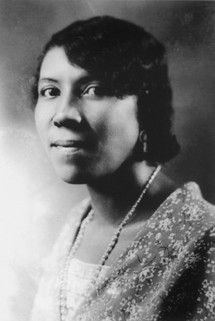Memphis Tennessee Garrison
Introduction
Text-to-speech Audio
Images
Memphis Tennessee Garrison (1890-1988). Courtesy Of Ohio University Press, publishers of Ancella R. Bickley & Lynda Ann Ewen, eds., "Memphis Tennessee Garrison: The Remarkable Story of a Black Appalachian Woman" (Athens, 2001)

Home and its current condition as of 2008. Photo courtesy of Herald-Dispatch of Huntington newspaper (2015)

Backstory and Context
Text-to-speech Audio
Memphis Tennessee Garrison was born in Hollins, Virginia on March 3 or 4, 1890. She was the daughter and granddaughter of slaves. Her family moved to Gary, West Virginia before her eighth birthday and Garrison grew up in southern West Virginia’s coalfields. She obtained a B. A. Degree from Bluefield State College located in West Virginia and continued to further her education at Ohio University in Athens, Ohio. During a time when women were less likely to display leadership roles, Garrison acted as a political leader. While living in McDowell County, West Virginia, which happened to have the richest coalfields in the United States and served as the home of U.S. Steel, Garrison arbitrated issues in within the community, as well as labor and race issues. During this time, she served as a mediator on her own, not belonging to any organization. In 1918 she heard about the NAACP and by 1921 she had established a branch in Gary, West Virginia.
From 1831 to 1846 Garrison worked as a mediator and welfare worker for U.S. Steel. She left the company after the United Mine Workers’ of America organized the miners at the coal company. Once, the miners began to unionize, Garrison’s role in the company changed, almost becoming obsolete. During this same time, she was becoming more committed to the NAACP and things that were taking place outside of her hometown of Gary, West Virginia.
Garrison began teaching in 1908 and did not retire until the 1950s. During the Great Depression, she made sure her students were fed. Garrison understood that students could not learn adequately on an empty stomach. She also took education outside the school walls and educated the coalfield community. Garrison brought explorers, plays and music to Gary, West Virginia exposing the community to different types of culture.
Garrison’s commitment to her students and the young Black population is what inspired her to organize. She was able to create an agenda that motivated both men and women, Black and white. When the Black teachers of West Virginia were organized into the West Virginia State Teachers’ Association, Garrison was the first woman to be elected as the organizations president.
In 1918 Memphis Tennessee Garrison married William Garrison. They couple never had kids, and with the help of her mother and support of her husband, Garrison was able to contribute more to her community and the Black population.
In 1952 Garrison moved to Huntington, West Virginia and soon after helped to establish a Black Girl Scout group in the city. While in Huntington, she inspired a new generation of Black youth.
For two years Garrison served as the NAACP’s treasurer. From 1956-1959 she was the NAACP National Field Secretary. Garrison also served as the national vice president of the NAACP Board of Directors from 1964 to 1966. Between 1963 and 1966 she was a member of the West Virginia Human Rights Commission and in 1964 a member of President Johnson’s National Citizens Committee on Community Relations.
Memphis Tennessee Garrison died on July 25, 1988 at the age of ninety-eight in Huntington, West Virginia. Garrison’s greatest legacy was her influence on the young Black women of McDowell County to pursue an education. In the 1920s she began the NAACP’s national Christmas seal campaign.
Throughout her life, she was honored for all the work she did for the Black community and civil rights. In 1929 Garrison received the NAACP’s Madam C. J. Walker Gold Medal Award. Her achievements in and services to the civil rights movement were honored in 1959 when she was the recipient of the T. G. Nutter Award. In 1969 she received the Distinguished Service Award from the NAACP. Marshall University in Huntington, West Virginia provided Garrison with an honorary Doctor of Humanities degree in 1970. She also was given the governor’s “Living the Dream” Award in 1988.
